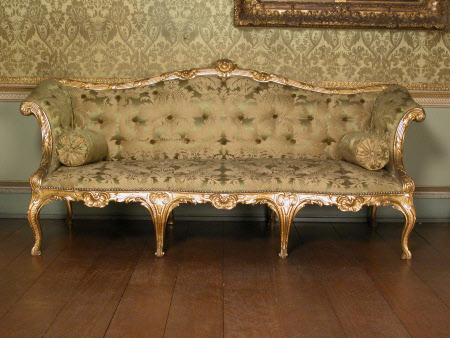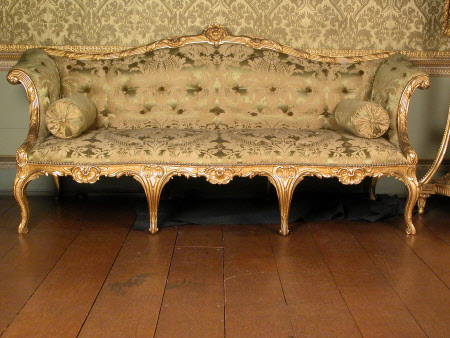Sofa
John Linnell (1729 - 1796)
Category
Furniture
Date
circa 1765
Materials
Beech, pine, water gilding, upholstery, silk, brass
Measurements
107 x 225 x 94 cm
Place of origin
Berkeley Square
Order this imageCollection
Osterley Park and House, London
NT 771771.2
Summary
A gilded beech and pine sofa, attributed to John Linnell (1729-96), circa 1765, one of a pair and part of a set with eight open armchairs (NT 711772.1 - .8). Having a serpentine back with a reeded toprail of fasces laced at intervals with acanthus leaves and centered by a rocaille ‘c’-scroll edged shell and leaf clasp, a further scroll-edged leaf clasp to either side. The scroll-over outswept arms fronted by confirming reeded arm supports formed as similar bunches of reeds or fasces, tied with a twining acanthus leaf. The serpentine-fronted seat rails centred by a shell and edged with foliate scrolls. Raised to the front on four moulded and rocaille-carved cabriole legs, carved to the knee with three enclosed flutes or palmettes within ‘c’-scrolls, the feet terminating at the front in an acanthus leaf and to the rear in a scroll. Raised to the rear on four conforming cabriole legs set at a significant rake. With apparently original webbing, and now upholstered in 1970s pea-green silk damask fixed to the seat rails with brass dome-headed nails, and with tufted buttons to the back and seat.
Full description
The set of eight chairs and two sofas of which this sofa is a part are believed to have been in the Drawing Room at Osterley Park since around 1765. The set was first recorded there in an inventory of 1782 as ‘Two large Soffas carved and gilt in burnish[ed] Gold with bolsters covered with pea green Silk Damask' and 'Eight large Elbow Chairs carved and gilt in burnish[ed] Gold covered with pea green Silk Damask linen and serge cases to the whole'. Celebrated architect and designer Robert Adam (1728-92) had probably modified and decorated the Drawing Room in 1765 or 1766, although some experts believe that Adam’s predecessor at Osterley, Sir William Chambers (1723-96), the architect employed by Robert Child’s (1739-82) older brother Francis (b. 1735) who died in 1763, could have been responsible for the room. It was probably considered slightly old-fashioned by the 1770s, and so was smartened up under Adam's direction in 1773, but these sofas and chairs, combining both Rococo (the shape, legs and seat rails) and neo-Classical (the backs and arms) elements – they are essentially transitional – almost certainly date from the previous phase of work. Adam designed both interiors and furniture at Osterley Park, but this set was almost certainly both designed and made by the cabinet-maker John Linnell (1729-96). No bill or correspondence survives to prove this, instead the attribution is based on the similarity of the chairs to a skilfully executed ink, pencil and watercolour wash drawing of a chair now in the collections of the Victoria & Albert Museum [E.93-1929], also dated by scholars to circa 1760-5 and attributed to Linnell. As was typical at the time, two alternative designs were presented in the same drawing, allowing the client a choice between different arm and leg styles. The Osterley Park chairs are not identical to the drawn chairs but are similar enough to allow the attribution. An almost identical set of chairs and sofas are at Alnwick Castle, home of the Duke and Duchess of Northumberland, who – like the Childs – used Linnell to furnish several properties. A set of eight gilded chairs of a comparable design supplied by Linnell to William Drake (1723-96) for Shardeloes near Amersham in Buckinghamshire in 1768 cost £39 4s; the companion pair of sofas, £24. Serge cases, which we know covered the chairs at Osterley (although not that they were supplied by Linnell), cost an additional £8 9s 2d in material and £1 16s for making up. Eight chairs, two sofas and ten cases cost Drake £73 9s 2d in total, a considerable investment and amongst the most expensive pieces of furniture he purchased from Linnell. How much the Childs spent on furniture by the Linnell firm it is impossible to say, as neither the bills relating to the commission, nor the Childs’ bank accounts covering these transactions, have been found. The Childs had almost certainly employed John Linnell’s father, William (1703-63), a carver, cabinet-maker and upholder, who founded the firm which John took over on his father’s death in 1763. A ‘Mr Child’ appears amongst a list of debtors drawn up following William’s death. No sum for this debt is given, nor for what it was incurred, but furniture historians have speculated that the debt may relate to the suite of twelve chairs and four sofas [NT 771737] with mahogany frames in the Gallery at Osterley Park. John Linnell took over the business on his father’s death, and appears to have been retained as the Child’s principal furniture-maker, not only for Osterley Park but also, probably, their other houses at Upton Park and 38 Berkeley Square, where they were neighbours of Linnell, whose workshop and home was at Number 28. Sarah Child (d. 1793) was still employing Linnell’s men to clean and repair her Berkeley Square house in the wake of her husband Robert’s death in 1782. The Linnell firm, under both William and John, produced furniture of the highest quality for distinguished clients and patrons. Up until around 1765, they produced furniture in the Rococo, Chinoiserie and Gothick styles. The former was heavily influenced by prevailing French styles. Indeed, these giltwood sofas and chairs at Osterley are typical of transitional mid-18th century canapés produced in France. The influence of French fashions was strengthened by John Linnell’s employment of Swedish cabinet-makers Georg Haupt (1741-84) and Christopher Fuhrlohg (1740-87) in 1767-68. Both men had worked in France and were probably responsible for the library furniture at Osterley [NT 771753, NT 771754.1 & .2, NT 771755.1 -.8 and NT 773350]. When Horace Walpole (1717-97) visited Osterley in July 1773, he described the Drawing Room as ‘worthy of Eve before the Fall’. But by 1871, when another inventory was taken, the giltwood Drawing Room furniture had become slightly shabby, and was described as a 'Drawing Room Suite of two 7ft 6 in Sofas, Cabriole Arm Chairs to match - Covered in Green satin damask and loose baize Cases, the damask very much worn and gilding slightly chipped'. This is probably why they were re-gilt, according to National Trust conservators, in the late 19th century, and they have been re-covered in pea-green silk damask – to match the silk which ‘hung round’ the walls - more than once, most recently in the 1970s. The chairs are currently (2022) undergoing conservation in the National Trust’s Royal Oak Foundation Conservation Studio at Knole in Kent.
Provenance
Osterley Park Heirloom Listed in the inventory taken at Osterley Park in 1782 as one of ‘Two large Soffas carved and gilt in burnish[ed] Gold with bolsters covered with pea green Silk Damask’.
Makers and roles
John Linnell (1729 - 1796), designer John Linnell (1729 - 1796), cabinetmaker
References
Hayward and Kirkham (1980): Helena Hayward and Pat Kirkham, William and John Linnell: Eighteenth Century Cabinet-Makers (Studio Vista: London, 1980), 2 vols., Vol. I, pp. 61, 114-20, 165-8; Vol. 2, Figs. 50, 51 & 248-9 Hayward, 1969: Helena Hayward, 'The Drawings of John Linnell in the Victoria and Albert Museum', Furniture History Vol. 5 (1969), 1-118, 26-7, Fig. 9 Kirkham, 1967: Pat Kirkham, 'The Careers of William and John Linnell', Furniture History, Vol. 3 (1967), 29-44, 29-44 Tomlin, 1986: Maurice Tomlin. “The 1782 inventory of Osterley Park.” Furniture History 22 (1986): pp.107-134., 109, 118

